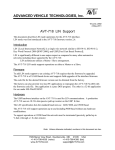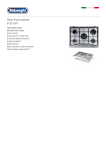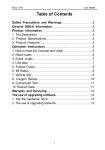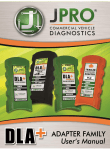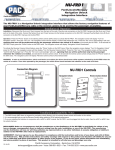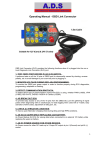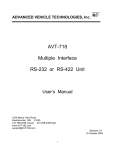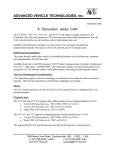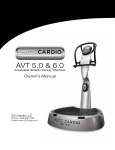Download Block Transfer Operations (PDF 15K).
Transcript
ADVANCED VEHICLE TECHNOLOGIES, Inc.
Inc.
AV
19 October, 2002
{ All numbers are Hex }
The J1850 specification does not support the transfer of more than 11 bytes of data (plus CRC) at
one time. However, there are times where it is desirable to transmit a block data greater than 11
bytes. (Such as GM’s Class 2 block download and block upload capabilities.)
Several AVT interfaces support this function (in VPW mode only), in both regular speed and
high speed modes. This is a summary of how to use the block data transfer functions.
The terms ‘download’ and ‘upload’ are not used here. In this paper block transfers are relative to
the AVT interface. Block transfers are either transmit (onto the VPW bus) or receive (from the
VPW bus).
There are two methods by which the host computer can send a block of data:
• Short Method or Transmit Command method.
• Block Specific method.
The AVT-718 interface supports both methods.
The AVT-716, 921, and 931 interfaces only support the “Block Specific” Method.
All AVT interfaces only support the receive method described in this document.
1509 Manor View Road, Davidsonville, MD 21035 USA
+1-410-798-4038 (voice)
+1-410-798-4308 (fax)
http://www.avt-hq.com
[email protected]
Transmit a Block:
Short Method
This method only applies to the AVT-718 interface.
The Short, or Transmit Command method, is an extension of the normal transmit command.
The sequence of events is:
• Host sends the AVT-718 interface the header byte(s) and the data to be transmitted.
• The AVT-718 interface receives the header byte(s) and data from the host.
• The AVT-718 interface buffers the data and checks the byte count.
• The AVT-718 interface transmits the data onto the network.
• The AVT-718 interface echoes the received block and/or reports status.
Note
This method is much simpler to use than the “Block Specific” method.
No other commands or specific sequence of events are required.
The AVT-718 interface checks the length of the message to be transmitted and handles it
accordingly. The host does not need to ‘tell’ the AVT-718 interface if it is a block or not.
Commands
There are three forms the host can use to command the AVT-718 to transmit a message or data.
They are described here, in the User’s Manual, and in the document titled: “Long Messages Alternate Header Formats.”
Normal Format
If the message is 15 bytes or less then the 'normal' format may be used.
0x aa bb cc ...
x - count of bytes to follow (message bytes).
aa bb cc ... message bytes.
Example:
05 81 F1 C1 48 9B
Alternate Format #1
If the message byte count is 16 to 255 (inclusive), alternate format #1 is available.
The header byte is $11; which indicates that one length byte follows. The data then follows.
11 xx aa bb cc ...
11 - header byte
xx - count of bytes to follow
aa bb cc ... message bytes.
Advanced Vehicle Technologies, Inc.
Page 2
Alternate Format #2
If the message byte count is between 256 and 8192 (inclusive), alternate format #2 is available.
The header byte is $12; which indicates that two length bytes follow. The data then follows.
12 xx yy aa bb cc ...
12 - header byte
xx - count of bytes to follow, most significant byte
yy - count of bytes to follow, least significant byte
aa bb cc ... message bytes.
Usage
All three formats are compatible and may be used as desired.
For example, the host wants to transmit the following message onto the bus:
A1 B2 C3 D4 E5 F6 A7 B8 C9 DA EB FC AD BE
Example
The following messages from the host to the AVT-718 interface are equivalent.
The header byte(s) are bold and underlined for clarity.
0E A1 B2 C3 D4 E5 F6 A7 B8 C9 DA EB FC AD BE
11 0E A1 B2 C3 D4 E5 F6 A7 B8 C9 DA EB FC AD BE
12 00 0E A1 B2 C3 D4 E5 F6 A7 B8 C9 DA EB FC AD BE
Note
The AVT-718 supports a maximum transmit block size of 8192 bytes (8 KBytes = $2000).
Commands to the Host for Block Transmit
The AVT-718 supports the following commands, associated with receiving a transmitted block.
52 21 00:
52 21 01:
52 40 00:
52 40 01:
Echo the transmitted block. {Default}
The entire transmitted block is echoed to the host, as it is received.
Do not echo the transmitted block.
Only the status message (transmit acknowledgment) is sent to the host.
Disable transmit acknowledgments.
Enable transmit acknowledgments. {Default}
Advanced Vehicle Technologies, Inc.
Page 3
Explanations
52 20 00 (the 52 40 xx command is irrelevant). Transmit a block of data.
Host receives from the AVT-718 the following:
F0 gg hh kk pp ... ss mm nn F0 F0 F0 F0 F0 F0 F0 F0 F0 F0 F0 F0 F0 F0 F0
The first “F0” indicates the start of a block being received.
“gg hh kk pp ...” are the actual block data bytes.
“ss” is the received status byte
(60 indicates transmitted successfully with no errors).
“mm nn” is the count of received data bytes (only).
The fifteen “F0” bytes signal the end of the block.
52 20 01 and 52 40 01. Transmit a block of data.
Host receives from the AVT-718 the following:
F3 ss mm nn
F3 indicates a block transmit report, 3 bytes follow.
“ss” is the received status byte
(60 indicates transmitted successfully with no errors).
“mm nn” is the count of received data bytes (only).
52 20 01 and 52 40 00. Transmit a block of data.
The AVT-718 does not reply at all to the host.
Receiving a block
The AVT-718 receives a block of data the same as the other AVT interface units.
That method is described later in this document.
Advanced Vehicle Technologies, Inc.
Page 4
Transmit a Block:
Block Specific Method
•
Send the command “53 20 xx yy” to the AVT interface.
•
(The bytes ‘xx’ and ‘yy’ are high and low order bytes, respectively, of the byte count of the
block of data to be transmitted.)
NOTE: Do not confuse the byte count in the “53” command with the block size in a
Class 2 Mode 36 message. The byte count in the “53” command is the total length
of the message, including all header, type, count, data, and CRC bytes - as defined
in the Mode 36 message.
•
Receive the response “62 20 01” which indicates that the AVT interface has entered block
transfer mode and it is ready to receive the data block from the host.
•
Within 3 seconds the host must begin to send the data block to the AVT interface.
•
There must not be more than approximately 256 microseconds between consecutive bytes
(64 microseconds when in high speed mode). This minimum time will vary depending on
how bytes are passed by the host to the interface, and other factors.
Not applicable to the AVT-718 interface.
•
The AVT interface will receive the same data block it is sending, it will be passed to the host.
(Refer to the receive description below.) This echo can be shut off by using the
52 21 01 command which enables the ‘no-echo’ feature. The command 52 21 00 disables the
‘no-echo’ feature, thus the transmitted block is echoed back to the host [this is the default].
•
When all the data has been sent to the interface (and all the data has been received from the
bus) the interface will respond with “62 20 00” to indicate that it has exited the block transfer
mode.
Example
Host
AVT interface
Bus
Command 5 20 xx yy
Response 62 20 01
---
xx yy ... N
---
SOF xx yy ... N CRC
---
Response 62 20 00
---
Advanced Vehicle Technologies, Inc.
Page 5
Receive a Block
•
•
No operator action is required to prepare the AVT interface to receive a block of data. If a
block transfer commences on the bus (at the same speed the interface is set for) the block will
be received and forwarded to the host.
When block transfer starts the AVT interface will send the host an “F0” byte to indicate that a
block of data will follow.
Note: The AVT interface has no advance information about the size of the incoming block.
Thus, it can only send an “F0” to indicate that reception of a block has started. The host
must be able to handle this.
•
•
•
•
•
Immediately following the “F0” byte will be the block of data.
The receive status byte is appended to the end of the data block.
The received block byte count, a two byte value (high byte - low byte) will follow the status
byte. The byte count will NOT include the status byte (the status byte is not part of the
message received).
A total of fifteen (15) “F0” bytes are appended. These serve to indicate the end of the block.
The AVT interface exits block receive mode.
(If in high speed mode, the interface stays in high speed mode.)
Examples
Receive a Block
⇒
⇒
⇒
⇒
⇒
AVT interface sends “F0” to the host.
AVT interface sends the received data block to the host.
AVT interface sends the receive status byte to the host.
AVT interface sends a two byte value of message byte count.
AVT interface sends fifteen (15) ‘F0’ bytes to the host.
Transmit a Block
⇒
⇒
⇒
⇒
⇒
⇒
⇒
⇒
⇒
Host sends 53 20 xx yy to the AVT interface.
AVT interface responds with 62 20 01.
Host sends data block to the AVT interface.
AVT interface sends “F0” to the host.
AVT interface sends the received data block.
AVT interface sends the receive status byte.
AVT interface sends a two byte value of message byte count.
AVT interface sends fifteen (15) ‘F0’ bytes.
AVT interface sends “62 20 00” to the host.
Advanced Vehicle Technologies, Inc.
Page 6
Error Condition and Notification
If the interface realizes that an error has occurred (e.g. the 3 seconds time-out) the interface will
respond with the error message $21 $32. A $62 $20 $00 message (exit from block transfer
mode) will follow.
Example:
⇒
⇒
⇒
⇒
⇒
Host sends: 52 20 01 - (Command block mode).
Interface responds: 62 20 01 - (Block mode entry acknowledged).
Error occurs: host delays sending data.
Interface responds: 21 32 - (Block mode error)
Interface responds: 62 20 00 - (Block mode exited).
There is an error that may occur during a block transmit operation. If the interface does not
receive a byte for transmission within the allowable time, the VPW bus will experience a timeout (EOD) and the block transfer will abort early. The AVT interface should detect this and will
read the remaining bytes from the host, discard them, send the error message ($21 $32) to the
host, and exit block mode ($62 $20 $00).
No Echo Mode Enabled
A ‘no-echo’ feature is included with the block transfer function. The default mode is
‘no-echo’ disabled. This means any block sent by the host will be echoed back to the
host.
Sending the command 52 21 01 will enable the ‘no-echo’ feature.
When enabled the received block is not echoed back to the host.
⇒ Host sends 53 20 xx yy to the AVT interface.
⇒ AVT interface responds with 62 20 01.
⇒ Host sends data block to the AVT interface.
⇒ AVT interface sends a $03 header byte.
⇒ AVT interface sends the receive status byte.
⇒ AVT interface sends a two byte value of message byte count.
⇒ AVT interface sends “62 20 00” to the host.
Advanced Vehicle Technologies, Inc.
Page 7







